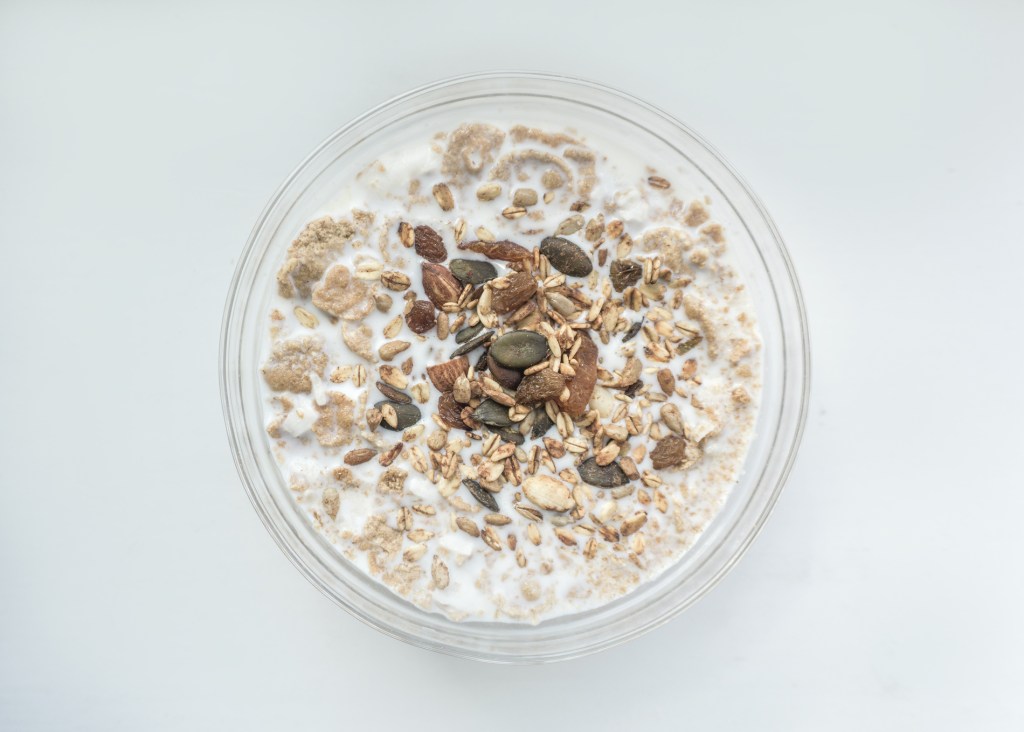Your cart is currently empty!
Replacing Dairy in Your Diet

The average American diet includes a lot of dairy. According to the USDA, each American consumed 646 pounds of dairy per person in 2018. That includes 146lbs of milk, 40lbs of cheese, 18 lbs of ice cream, 13lbs of yogurt, and 6 lbs of butter – holy cow! It is also 107 more pounds per…
Why so much dairy?
Cow’s milk is a mixture of fat, sugar, protein, and hormones. The components found in milk react with our bodies and brains to release “feel good” chemicals (serotonin and dopamine). Our enjoyment of dairy comes down to fat and sugar. Cheese is very high in fat and ice cream is high in both fat and sugar. We love to consume dairy!

Why shouldn’t we consume it?
Although dairy has become a staple of the American diet, we may have been tricked into thinking it is better for us than it actually is (Remember the Got Milk campaign?) An article in The New England Journal of Medicine stated that “the health benefit of a high intake of milk products has not been established and concerns exist about the risk of possible adverse health outcomes. Therefore, the role of dairy consumption in human nutrition and disease prevention warrants careful assessment.”

The risks associated with dairy consumption:
- Saturated Fats: Dairy contains high levels of saturated fat, which can elevate blood cholesterol levels and increase the risk of heart disease.
- Prostate Cancer: The risk of prostate cancer can be increased by milk consumption.
- Acne: Dairy worsens acne and irritates skin. This is because of the natural hormones found in milk, as well as the artificial hormones given to cows to increase milk production.
- Ovarian Cancer: Studies have shown a link between dairy consumption and an increased risk of ovarian cancer. A study published in 2000 warns that, “women who drink two or more glasses of milk a day have a 44% higher risk of getting ovarian cancer than women who rarely drink milk.”
- Environmental Impacts: A 2018 study estimated that dairy milk emits 3x more greenhouse gasses than plant-based milks.
- Lactose Intolerance: Up to 75% of the world’s adult population is lactose intolerant, with some ethnic groups up to 90%. Lactose intolerance can cause bloating, stomach pain, flatulence, diarrhea, constipation, and even vomiting.

Milk
There are currently around 20 different milk substitutes on the market, with the most popular being oat, soy, almond, and coconut. Milks can be created from grains, nuts, seeds, and beans. Plant-based milks have been a rich part of human history. In 8th century Spain, Horchata was made from dried and ground tiger nuts. Almond milk was featured in 13th century Baghdadi and English cookbooks as well as 14th-century Egyptian recipes. Soy milk was also prevalent in China in the 13th century.
In recipes, you can use plant milk as a substitute for milk in a 1:1 ratio. In baking, oat milk and almond milk typically produce the best result. You can find many different varieties of plant milk in your grocery store, or even make some yourself!
EASY NUT MILK
- 1 cup raw cashews, sunflower seeds, or hemp seeds (soaked for at least 4 hours)
- 3 cups water (more or less depending on how thin or thick you want it)
- 1 tsp vanilla extract (optional)
INSTRUCTIONS:
- Blend very well until creamy, about 2 minutes.
- Store in an airtight container and shake before serving.

Cream:
Cream is thick, creamy, and high in fat. It gives a certain decadence to food, both sweet and savory. You can use cashews, coconut cream, silken tofu, chickpeas, potatoes, cauliflower, and aquafaba to replace cow’s cream. These ingredients can be used in different ways and recipes to create a creamy texture.
Homemade Cream Recipes:

Butter:
We love butter because it is pure fat! To replace the fats found in dairy, oils must be used. A couple of great plant-based butters are currently on the market, including Earth Balance, Country Crock Plant Butter, I Can’t Believe It’s Not Butter, Miyokos, and Simple Truth. Try to make sure that they are non-hydrogenated, as hydrogenated oils contain trans fats and can increase cholesterol.

Yogurt:
Plant-based yogurts are becoming more and more common on supermarket shelves. Commercial yogurts are made from oat, soy, coconut, almond, cashew, and flax milk.
DR. YAMI’S INSTANT POT VEGAN GREEK YOGURT
- 2 cups raw cashews, soaked overnight and drained
- 1 can coconut milk (full fat)
- 1 packet vegan yogurt starter
INSTRUCTION:
- Blend soaked cashews and coconut milk until smooth.
- Add the cashew mixture to your instant pot.
- Add the starter and stir well with a whisk until completely incorporated.
- Push the yogurt button on the instant pot and set to 12 hours.
- Turn the steam valve to “vent” to allow humidity to escape.
- Once done, let it cool to room temperature and transfer to sealed containers.

Cheese:
There is an extremely high demand for vegan cheese. Current popular brands include Daiya, Field Roast Chao Cheese, Treeline, So Delicious, Kite Hill, Follow Your Heart, Violife, and Vromage. Miyokos also makes artisan plant-based cheeses, perfect for a charcuterie board. The Field Roast Chao Cheese Creamy Original is great in sandwiches and melts nicely.
You can also use nutritional yeast to get a cheesy flavor in pastas, soups, and dips. Nutritional yeast is an amazing source of B-vitamins and protein, especially B-12 which is important for brain health. It is also a complete protein, meaning it contains all of the amino acids our body needs, but cannot produce itself. Tofu and cashews are also often used to create cheesy textures.











